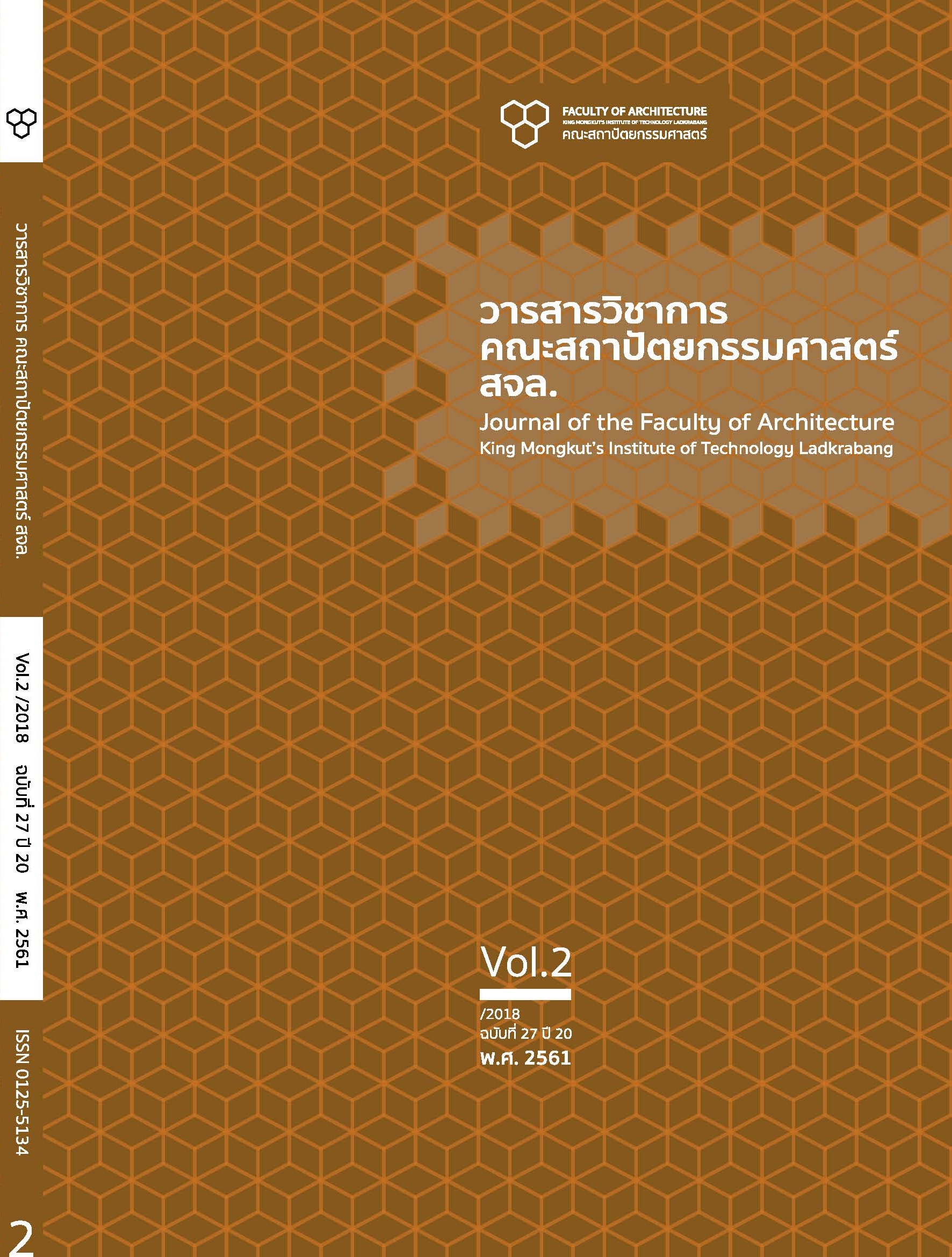การเพิ่มประสิทธิภาพของโซเดียมซิลิเกตด้วยน้ำปูนใสเพื่อการเพนท์ผ้าฝ้ายด้วยสีรีแอคทีฟ Optimization of Sodium Silicate with Limewater (Calcium Hydroxide) for Painted Cotton with Reactive Dyes
Main Article Content
Abstract
บทคัดย่อ
การวิจัยครั้งนี้มีวัตถุประสงค์เพื่อศึกษาการเพิ่มประสิทธิภาพของโซเดียมซิลิเกตด้วยน้ำปูนใสเพื่อการเพนท์ผ้าฝ้ายด้วยสีรีแอคทีฟสูตรโซเดียมซิลิเกตและระยะเวลาในการหมักผ้าเพนท์ที่เหมาะสม และเปรียบเทียบความเข้มของสีที่ติดบนผ้าที่ใช้สูตรและระยะเวลาที่ต่างกัน โดยใช้สีรีแอคทีฟจำนวน 6 สี คือ สีเหลือง สีชมพู สีแดง สีฟ้าน้ำทะเล สีน้ำเงิน ที่ระดับความเข้มของสี 5 เปอร์เซ็นต์ และสีดำที่ระดับความเข้มของสี 8 เปอร์เซ็นต์ น้ำปูนใสเตรียมจากปูนขาว อัตราส่วน ปูนขาวต่อน้ำเท่ากับ 1 กิโลกรัมต่อน้ำ 10 ลิตร ผ้าที่ใช้ในการทดลองเป็นผ้าฝ้ายเนื้อบางสีขาว ผ้าเพนท์ สีหมักด้วยโซเดียมซิลิเกต 3 สูตร คือ สูตรที่ 1 โซเดียมซิลิเกตเข้มข้น สูตรที่ 2 โซเดียมซิลิเกตเข้มข้นผสมน้ำอัตราส่วน 4:1 สูตรที่ 3 โซเดียมซิลิเกตเข้มข้นผสมน้ำปูนใสอัตราส่วน 3:2 ระยะเวลาในการหมักผ้า 3 ระดับ คือ 1 3 และ 6 ชั่วโมง การวิเคราะห์ผลกระทำโดยการดูจากความเข้มของสี ที่ติดบนผ้าฝ้ายด้วยสายตาภายใต้แสงธรรมชาติเพื่อเปรียบเทียบความแตกต่างของสีผ้าที่ปรากฏ ผลการศึกษาพบว่า สูตรโซเดียมซิลิเกตทั้ง 3 สูตร และระยะเวลามีผลต่อการติดสีของผ้าฝ้าย สูตรที่ 1 การติดสีเหลืองของผ้าฝ้ายดีทั้ง 3 ระยะเวลา ส่วนสีชมพู สีแดง สีฟ้าน้ำทะเล สีน้ำเงิน ติดสีดีที่เวลา 6 ชั่วโมง และสีดำติดสีดีที่เวลา 1 และ 6 ชั่วโมง สูตรที่ 2 การติดสีทั้ง 6 สี ของผ้าฝ้าย ติดสีดีที่เวลา 6 ชั่วโมง สูตรที่ 3 การติดสีเหลืองของผ้าฝ้ายดีทั้ง 3 ระยะเวลา ส่วนสีชมพู สีแดง สีน้ำเงิน ติดสีดีที่เวลา 3 และ 6 ชั่วโมง สีฟ้าน้ำทะเล ติดสีดีที่เวลา 6 ชั่วโมง และสีดำ ติดสีดีที่เวลา 1 และ 6 ชั่วโมง จะเห็นได้ว่าโซเดียมซิลิสูตรที่ 3 การติดสีของผ้าฝ้ายดีกว่าสูตรที่ 1 และ 2 ใช้เวลาในการหมักผ้าน้อยใช้งานง่ายสะดวกรวดเร็วและประหยัดค่าใช้จ่าย สูตรที่ 3 จึงเป็นสูตรที่เหมาะสมที่สุดสำหรับการหมักผ้าเพนท์ น้ำปูนใส จึงเป็นสารเพิ่มประสิทธิภาพของโซเดียมซิลิเกตในการเพนท์ผ้าฝ้ายด้วยสีรีแอคทีฟ
คำสำคัญ: น้ำปูนใส โซเดียมซิลิเกต สีรีแอคทีฟปูนขาว ผ้าฝ้าย
Abstract
The purpose of this research is to investigate the optimization of sodium silicate with limewater for cotton painted with reactive dyes, formula of sodium silicate and appropriate time for ferment, and comparison of color intensity on the fabric by using different formula and time. Reactive dyes had 6 colors: yellow, pink, red, turquoise, and blue at 5 percent and black at 8 percent. Limewater is from 1 kg. of lime per 10 liters of water. The painted fabric was fermented by sodium silicate formulas: 1) concentrated sodium silicate, 2) the ratio of sodium silicate to water was 4:1 and 3) the ratio of sodium silicate to limewater was 3:2. The duration of fermentation have 3 levels, 1, 3 and 6 hours. The analysis was done by looking at the intensity of the color on the painted fabric in natural light to compare the difference. The results showed that all 3 sodium silicate formulas and ferment duration affect the color intensity of the painted fabric. For the first formula, yellow was effective at all 3 periods, but pink, red, turquoise and blue were efficient at 6 hours. Black was good at 1 and 6 hours. For the second formula, all 6 colors were active at 6 hours. For the third formula, yellow was efficient at 3 periods, but pink, red and blue were effective at 3 and 6 hours. Turquoise was good at 6 hours and black was effective at 1 and 6 hours. It can be seen that the third formula was more successful than the first and second formulas. It saves time and cost for fermentation as well as is easy to use. The third formula, then, was the best. The limewater, thus, optimizes the efficiency of sodium silicate as reactive dyes on painted fabric.
Keywords: Limewater, Sodium Silicate, Reactive Dye, Lime, Cotton
Article Details
This work is licensed under a Creative Commons Attribution-NonCommercial-ShareAlike 4.0 International License.
Copyright Transfer Statement
The copyright of this article is transferred to Journal of The Faculty of Architecture King Mongkut's Institute of Technology Ladkrabang with effect if and when the article is accepted for publication. The copyright transfer covers the exclusive right to reproduce and distribute the article, including reprints, translations, photographic reproductions, electronic form (offline, online) or any other reproductions of similar nature.
The author warrants that this contribution is original and that he/she has full power to make this grant. The author signs for and accepts responsibility for releasing this material on behalf of any and all co-authors.
References
ผ่องศรี รอดโพธิ์ทอง. (2558). เอกสารประกอบการสอนรายวิชาพื้นฐานการออกแบบสิ่งทอภาควิชาศิลปอุตสาหกรรม. กรุงเทพฯ: สถาบันเทคโนโลยีพระจอมเกล้าเจ้าคุณทหารลาดกระบัง.
มยุรี ปาลวงศ์ แ ละ อภิรัฐ ธีรภาพวิเศษพงษ์. ( 2559). ทรายแก้วเป็นสารเคมีได้อย่างไร. เข้าถึงได้จาก: http://www.dpim.go.th/service/download?articleid=358&F=418.
ศรีนรา แมเร๊าะ. (2545). ดินและน้ำ. เข้าถึงได้จาก: http://www.natres.psu.ac.th/radio/radio_article/radio44-45/44- 450030.html.
สนั่น บุญลา. (2555). ผ้าฝ้าย. เข้าถึงได้จาก: https://www.thaitextile.org/index.php/blog/2016/02/th.
อรุณี คงดี อัลเดรด. (2559). เอกสารประกอบการสอนรายวิชา คอ 362 กระบวนการทางเคมีสิ่งทอ. เข้าถึงได้จาก: http://www.science.mju.ac.th/chemistry/download.


